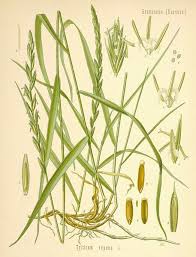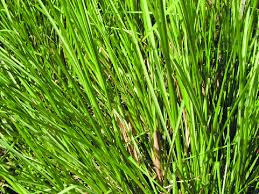Plamarosa (Cympobogon martinii) is a tall, aromatic grass belonging to the same family as lemongrass and citronella. It is native to India and Pakistan, but now cultivated extensively in Madagascar, Indonesia, Brazil and the Comoros Islands.

The plant is also closely related to sofia or gingergrass, which grows best on damp, poorly drained soil in humid valleys or forests. The true palmarosa variety, on the other hand, prefers a well-drained soil on sunny mountain slopes and forest clearings, and yields a finer-quality essential oil.
The aromatic grasses are regarded as nature's impersonators, for they contain aromatic molecules which resemble the fragrances of more highly prized aromatics. The essential oil of palmarosa, for instance, is sometimes added to the more expensive geranium oil, whereas lemongrass is sometimes added to melissa (lemon balm) oil to make it cheaper.
In the 18th century, palmarosa oil was more commonly known as Indian geranium, or Turkish geranium, oil. It was shipped from Bombay to Constantinople and Bulgaria, where it was often used to dilute the hugely costlier rose oil. Although Indian palmarosa oil continues to be produced in large quantities, the softer, more rosy scent of the oil produced in Madagascar is often preferred by connoisseurs of fragrance ingredients. Commercially, the oil is used as a fragrance in soaps, perfumes and cosmetics, as well as to flavour tobacco.
How It's Produced
The essential oil of palmarosa is extracted by steam distillation of the fresh or dried grass. It is pale yellow or olive liquid with a sweet, rosy scent reminiscent of lemongrass and geranium. Gingergrass oil is generally regarded as inferior, having a comparatively harsh aroma with a spicy undertone. Sometimes the two grass types are distilled together, the palmarosa lending geranium-like notes to the resulting oil.
Healing Benefits

In Ayurveda (the traditional medicine practised in India) both the essential oil and dried grass of the palmarosa plant are used for healing. The oil is incorporated into ointments and massage oils for treating rheumatic aches and pains, sciatica and neuralgia.
While a tea prepared from the dried grass is recommended for various types of fever, digestive problems and intestinal infections.
Palmarosa essential oil's most common application is for the treatment of skin problems and general skin care. Like lavender and neroli, it has a reputation for stimulating the growth for healthy skin cells and regulating sebum production; while its cooling, anti-inflammatory nature makes it helpful for dry eczema and other skin rashes. The oil also has a reputation for hydrating patched skin, hence its popularity in aromatherapy products designed for handcare and for treating crepey skin on the neck. Many aromatherapists recommend palmarosa oil as part of the treatment for acne. This is because it contains a high proportion of geraniol, a natural bactericide with a gentle effect on the skin.
On the emotional level, the scent of palmarosa is generally perceived as calming, yet also uplifting. Although it blends well with a wide variety of other essential oils, the aroma of a fine quality palmarosa essential oil works just as well by itself. It makes a delightfully soothing bath or massage oil.